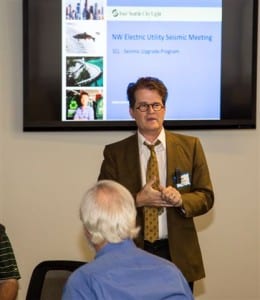

City Light Sr. Civil Engineer Robert Cochran speaks to group from around the Northwest interested in seismic risk to the electrioc grid.
Understanding the seismic vulnerabilities utilities in the Pacific Northwest have and encouraging mitigation before the next big earthquake hits was the goal of the first meeting of the Northwest Electric Utility Seismic Group on Oct. 15.
Seattle City Light hosted the meeting, which drew representatives from 10 utilities across the region. Discussions included seismic vulnerabilities of a high- voltage transmission system, understanding the geology of your utility’s service territory, hazard reduction opportunities, and a post disaster response scenario.
City Light Sr. Civil Engineer Robert Cochran organized the group and the event to increase awareness of the risk earthquakes pose to utilities. He was inspired to do so after learning he was the only engineer from the state of Washington participating in a working group that is developing seismic substation standards for the Institute for Electrical and Electronics Engineers (IEEE).
“Since earthquake hazards pose the greatest threat for having long-term massive power outages, I became very concerned that our region may be at significant risk,” Cochran said. “There’s now so much accessible information of how to harden a substation against seismic loading which can be incorporated at minimal cost to utilities. It’s a win-win situation for everyone.”
Experts say the Pacific Northwest is long overdue for a major earthquake event, whether it is the Cascadia subduction zone earthquake – an extreme earthquake on par with recent quakes in Japan and Chile – or an earthquake associated with the Seattle Fault, which is a potent shallow fault crossing through south downtown Seattle. Strengthening and hardening technologies backed by seismic research can minimize the damage an extreme event would have on the Northwest power grid.
A shallow fault earthquake generates large accelerations and would likely cause more damage to substation utilities than a subduction event, which would have more motion but lower accelerations. A subduction event would tend to cause more damage to long period structures like high-rise buildings in Seattle.
Guest speakers include Dr. Leon Kempner, principal structural engineer and seismic program manager at Bonneville Power Administration, and William Steele, a seismologist from the University of Washington.
Kempner discussed the seismic mitigation investments BPA has put in place and how it is continuing to harden its infrastructure. Among those projects are anchoring high-voltage transformers, researching new base isolation technology designed to protect those transformers, and creating model validation tools for seismic assessment of structural systems.
“Electricity will be critical to the region’s recovery from a potent seismic event,” Kempner said. “This meeting is a great opportunity for Northwest utilities to learn more about what everyone’s doing seismically.”
Cochran said the group will continue to reach out to other utilities throughout the region to share information and seek out new ideas.
“My hope is that word can get to decision makers within regional utilities who can put into place some level of upgrade program,” Cochran said. “Some minimal low cost approaches can still provide substantial benefits to utilities after the next earthquake.”